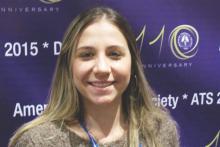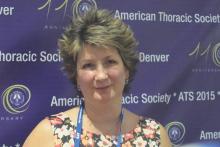DENVER – Obstructive sleep apnea was common among patients in the multinational Sleep and Stent Study who underwent successful percutaneous coronary intervention, but most of those affected had no daytime sleepiness, and only about half had positive findings on the Berlin Questionnaire.
Further, findings at up to 4 years of follow-up show that coronary artery disease patients with vs. without obstructive sleep apnea (OSA) had nearly twice the risk of adverse events.
The findings suggest that OSA has important clinical implications for coronary artery disease (CAD), and that validated tools for identifying OSA risk in the general population may not be useful in those with cardiovascular disease, Sofia Furlan, Ph.D. said in a press briefing at an international conference of the American Thoracic Society.
Of 1,305 patients included in the ongoing observational study, 45% had OSA, including 21.8% who had severe OSA defined by an apnea-hypopnea index of 30 or more events/hour. Excessive daytime sleepiness, defined as an Epworth Sleepiness Scale score of greater than 10, was identified in 24.5% of the OSA patients, and a Berlin Questionnaire score indicative of high risk for OSA was found in 54.3% of patients with OSA, said Dr. Furlan of the University of Sao Paulo, Brazil.
The adverse event rate was 11% in CAD patients with OSA, compared with 6.5% in those without OSA – a significant difference thus far in the study, Dr. Furlan noted.
Patients in the Sleep and Stent Study, which was designed to look at the relationships between OSA and cardiovascular outcomes in adults treated with percutaneous coronary intervention, were aged 18-80 years and were enrolled from eight centers in five countries: Singapore, China and Hong Kong, India, Myanmar, and Brazil.
Indications for percutaneous coronary intervention included ST segment elevation myocardial infarction in 33% of subjects, non-ST segment elevation myocardial infarction in 20% of subjects, unstable angina in 16% of subjects, and stable angina in 31% of subjects. All patients underwent an overnight sleep study using a level-3 portable diagnostic device prior to hospital discharge, and the tracings were analyzed by a blinded sleep physician.
The prevalence of OSA was comparable across study sites, Dr. Furlan said.
The findings reinforce the known association between OSA and cardiovascular disease, lead researcher Dr. Luciano Drager, also of the University of Sao Paulo, said in a press statement.
“Earlier studies have shown strong relationships between sleep apnea and a number of cardiovascular conditions, including high blood pressure, arrhythmia, stroke, and heart failure. Our study supports this strong association between OSA and heart disease and also suggests that the methods used to screen for OSA in patients with cardiovascular disease need to be improved,” Dr. Drager said.
Given the apparent association between sleep apnea and adverse outcomes in patients with CAD, and the fact that sleep apnea is underdiagnosed, it may be time to consider monitoring for sleep apnea in CAD patients, Dr. Furlan added.
Non–sleep related predictors of OSA in patients with cardiovascular disease also should be explored, she said.
Press briefing moderator Dr. Mihaela Teodorescu of the University of Wisconsin, Madison, noted that other studies also have suggested that coexistent OSA manifests differently in different disease states.
“This is a very good example. Whereas in the general population sleepiness is one of the major presenting symptoms, in this particularly vulnerable population with heart attacks and severe coronary artery disease, these people are not sleepy, ” she said, adding that “current screening questionnaires, which are relatively widely used in clinical populations, may not do the job.”
In fact, if traditional criteria for diagnosis are used, a large proportion of patients with OSA will be missed, she said.
“To me as a clinician, this is the major take-home message: Don’t rely on symptoms, because we will miss a large proportion of patients simply based on that.”
The investigators reported having no disclosures. The Sleep and Stent Study is sponsored by Boston Scientific Corporation.



